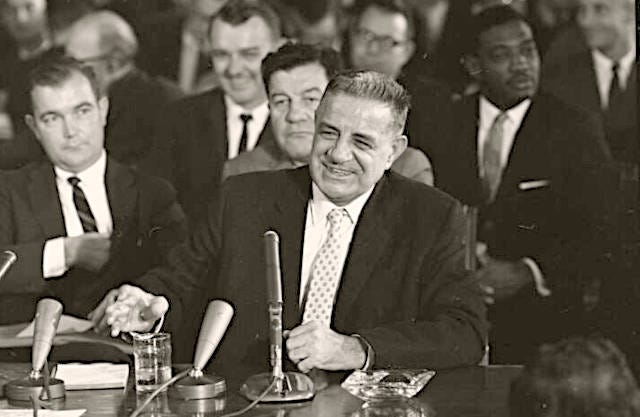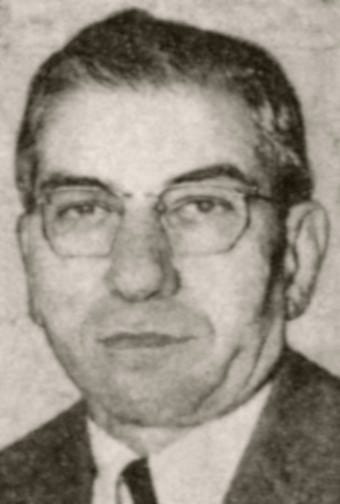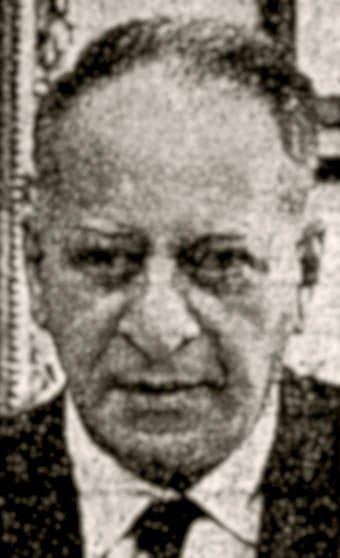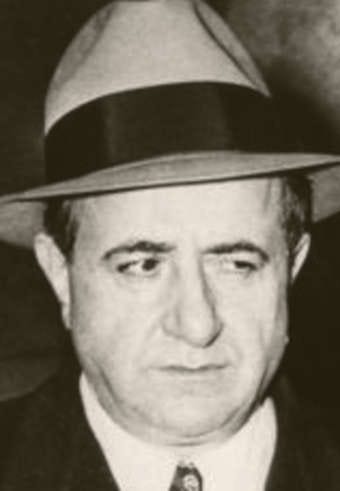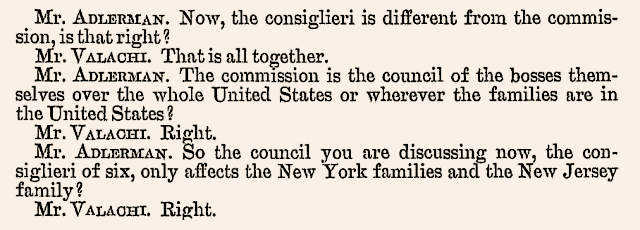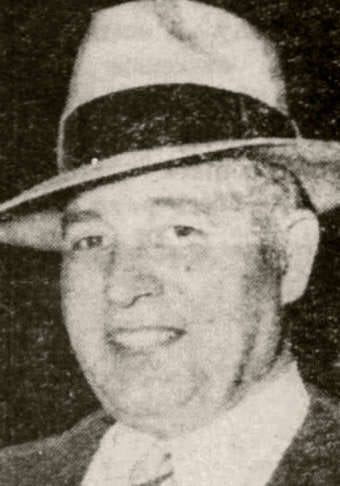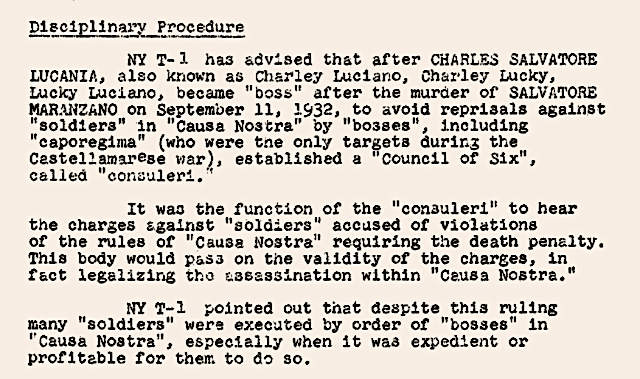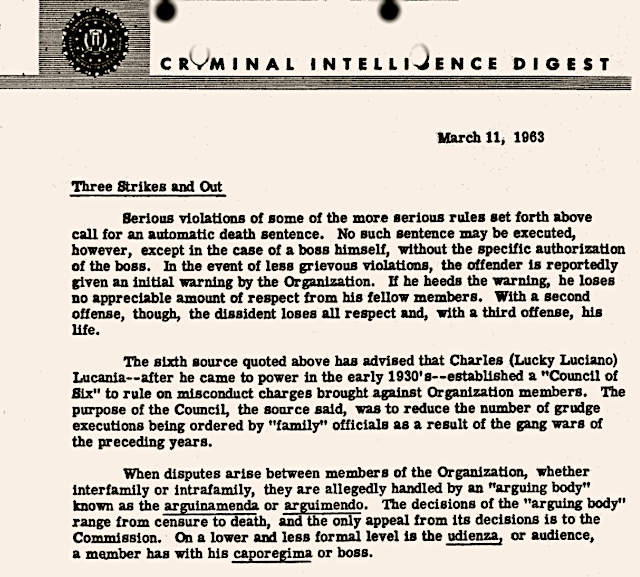During October 1963 testimony before the U.S. Senate's Subcommittee on Investigations (McClellan Committee), Mafia turncoat Joseph Valachi described a “group of six” set up in the 1930s by Salvatore “Charlie Luciano” Lucania to oversee disciplinary actions in the crime families of the New York-New Jersey area.1
According to Valachi, this group - also known as the “Council of Six” - served in a judicial capacity for the region's Mafia organizations. Ordinarily, crime family bosses were in complete control of the lives of their family members. But Lucania devised the regional council to ensure that bosses did not condemn members to death for frivolous or entirely personal reasons, Valachi said. It seems the council evolved to consider more than boss sentences of death against members. Violations of underworld rules and conflicts between members could be brought before the council, which could endorse disciplinary measures or arrange a compromise.
Here is a portion of Valachi's discussion of the council with Jerome S. Adlerman, general counsel of the Subcommittee on Investigations:
Mr. Valachi. ...He [Lucania] also put in, you know, a new consiglieri to protect the soldiers.
Mr. Adlerman. You mean a group of men?
Mr. Valachi. Yes, a group of six.
Mr. Adlerman. What was their function?
Mr. Valachi. For instance, a lieutenant wants to have a soldier killed or something ... in that line, he cannot do it no more. If he has anything he wants to do, anything like that, he must come up and talk to these six and state ... his reasons before he is able to carry out, which they never did that before. That is why the soldiers felt that they have a longer life now than ever, which they did.
Mr. Adlerman. Was this the result of the fact that there were a great many grudges and feuds going on because of the various killings?
Mr. Valachi. Actually, it was the result of the way Joe Masseria was working... In other words, they were protecting and trying to say for the other soldiers what was happening to them when they were in the Masseria administration.2
Valachi's use of the term "consiglieri" to refer to the Council of Six caused Adlerman to reflect on the position of consigliere within the crime family hierarchy. In an exchange between the two men, Valachi seemed to indicate that the consiglieri of the crime families of New York and New Jersey were assigned to be the sitting members on the Council of Six. Valachi further stated that any crime family boss could insert himself into the council to resolve a voting deadlock.
Mr. Adlerman. Did each of the families have a consiglieri?
Mr. Valachi. Yes, at that time.
Mr. Adlerman. How many consiglieri?
Mr. Valachi. They had six. If they need a decision, then a boss makes seven. It could be any boss to make it seven because six is even. It might be three and three. So there would be no decision. So a boss would sit down.
Mr. Adlerman. There were six families, five in New York and one in New Jersey?
Mr. Valachi. Yes.
Mr. Adlerman. Each of those had one consiglieri?
Mr. Valachi. Yes.3
Adlerman then tried to summarize the information presented by Valachi:
Mr. Adlerman. If for any reason a lieutenant, boss or somebody, wished to kill some soldier, they first had to go to the court or the council?
Mr. Valachi. That is it.
Mr. Adlerman. And prefer a charge which the council or consiglieri would hear and make a determination whether the boss or lieutenant was justified in killing the soldier?4
Valachi continued the discussion by referring to the violation of Mafia rules he committed by physically striking another mafioso. The situation arose when he learned that his partner in the Lido Restaurant (Castle Hill section of the Bronx), Frank Luciano of the Mangano Crime Family, had been stealing money from the business. Luciano brought a grievance against Valachi to their superiors. A hearing at Duke's Restaurant in New Jersey was arranged with Mangano underboss Albert Anastasia presiding. (Valachi indicated that this initial hearing of the charge should have occurred before Luciano's immediate superior “Staten Island Joe” Riccobono, but Riccobono was ill.)5
Valachi's superior “Tony Bender” Strollo accompanied him to the hearing. Anastasia's aide “Charley Brush” Zangarra also was in attendance. After hearing the charge, Anastasia scolded Valachi for his lapse in judgment. He then determined that the Lido partnership should be dissolved. He called for Valachi to buy out Luciano's $15,000 share at a discounted price of $3,500 and for Luciano to maintain the business's liquor license (under the name of his son Anthony) for as long as Valachi required it. The terms were acceptable to those involved.6
Mr. Valachi. ...you take the time when I was in New Jersey when Albert Anastasia sat down... If that had not been settled there that would have gone up to the consiglieri [Council of Six]. That was the purpose why Albert was there...
Mr. Adlerman. This is the incident where you had the fight with your partner. You had struck your partner physically which was against the rules. You were brought into the council in New Jersey, is that right?
Mr. Valachi. If he had saw fit and went to the council, we would have gone to the council, but it ended there, it never got up there.
Mr. Adlerman. It did not go up to the appeals court?7
Valachi said he was relieved by Anastasia's resolution of the matter. He was concerned about what might happen to him if the matter moved on to the Council of Six: “I don't think they would have saw me any more.”8
Given that the dispute resolution function of the Council of Six might cause that judicial body to be confused with the national Mafia Commission, Adlerman made an effort to clarify:
Mr. Adlerman. Now, the consiglieri is different from the commission, is that right?
Mr. Valachi. That is all together.
Mr. Adlerman. The commission is the council of the bosses themselves over the whole United States or wherever the families are in the United States?
Mr. Valachi. Right.
Mr. Adlerman. So the council you are discussing now, the consiglieri of six, only affects the New York families and the New Jersey family?
Mr. Valachi. Right.9
Read and interact with MobHistory’s short-form content in Substack Notes.
Valachi memoirs
Around late June of 1964, the U.S. Department of Justice urged Joseph Valachi to write down his recollections of his life in the Mafia. He devoted himself to that task for the next thirteen months.
In the extensive memoirs he compiled, Valachi recalled how the council, initially designed to prevent selfish murders, was manipulated by Vito Genovese to achieve the death of Guarino “Willie Moore” Moretti. A top man in the former Lucania organization then commanded by Frank Costello, Moretti was an obstacle to Genovese's ambitions. He was also a general concern of others in the underworld, as he was afflicted with a condition that often impaired his judgment and his discretion. Genovese conducted a lengthy whisper campaign, suggesting Moretti was losing his mind, represented a threat to the mob and should be eliminated in a “mercy killing.” With those seeds planted, any perceived Moretti mistake became damning evidence of a menacing mental decline. In that way, according to Valachi, Genovese predetermined the outcome of a case before the council:
Genovese had a plan in mind and he is taking all his time because he wants everything that he does to be legal... I will explain now what I mean by using the word legally. It mean when a member's life is at stake, they, the Mob, have what we call the councilmen, they are the ones who will decide on Willie Moore Moretti if he is losing his mind and that is what Vito Genovese is leading up to. He is building it up.
Eventually, the council decided that Willie Moretti had to be dealt with. According to Valachi, Genovese also managed to convince the council that Moretti's brother, Salvatore “Solly,” then in prison, also needed to be murdered.10
(Salvatore Moretti died in New Jersey State Prison on June 8, 1952. He was forty-nine years old and serving a sentence of two to three years for operating craps games in Bergen County. He reportedly suffered a cerebral hemorrhage in early May, just before he was scheduled for a parole hearing, but then apparently recovered. His death about a month later was attributed to natural causes. No autopsy was performed. In February of 1954, state Attorney General Grover Richman, reacting to rumors that Salvatore Moretti was murdered, inquired about the circumstances of Salvatore's death. Data was lacking.11)
Earlier statements
The exchanges with Jerome Adlerman appear to have contained Valachi's most detailed statements with regard to the regional Council of Six, and the memoirs revealed how the council could be misused, but Valachi had spoken earlier about the judicial panel, and those discussions were recorded in FBI documents.
In a recent exchange of text messages on this subject, Mafia historian David Critchley shared copies of a document dated September 26, 1962, which discussed the Council of Six. This document may be the earliest written mention of the council.12
Valachi became an informant for the Federal Bureau of Narcotics (FBN) following his July 17, 1962, guilty plea to a second degree murder charge in Atlanta. FBN officials took him from Atlanta and placed him in the Westchester County Jail in New York State, where the agency housed a number of informants. Through much of August 1962, Valachi was interviewed by FBN agents. The FBI caught wind of Valachi's revelations and, near the end of that month, J. Edgar Hoover's Bureau began demanding that Valachi be turned over to its control. Special Agent James P. Flynn of New York's FBI office was given access and reportedly won Valachi's confidence around September 8, 1962.
Near the end of September, Valachi was transferred to the exclusive control of the FBI. Flynn’s interviews of Valachi intensified. The Bureau found that information provided by Valachi confirmed and clarified much of the Mafia data it already had accumulated through illegal electronic surveillance. The discussion of the Council of Six occurred in the opening stages of Valachi's cooperation with the FBI.13
The details provided in the September 26 report were somewhat contradictory. While stating that each crime family dealt on its own with its disciplinary issues, Valachi provided clues to the collaborative nature of the Council of Six:
According to Valachi, a “finger man” is not used [in mob hits], for each “family” takes care of its own problems. One “family” does not know what the other is doing.
Valachi pointed out that when Luciano took power he instituted a “Council of Six” or “Consuleri,” that heard all charges or accusations against “button men” or “soldiers.” It was mandatory that this body authorize any execution of a “button man” for his murder to be “legal” in the organization. Valachi stated that prior to this time a “boss” could summarily kill any of his men for violations. Luciano instituted this body to prevent the “bosses” killing “button men” who had fought against them in the Castellamarese [sic] war for revenge. Valachi could only recall two individuals on this body today, naming them as Vincent John Rao and Joseph Biondo.14
The statements about families acting on their own and about Lucania instituting the council concept could suggest to some that the council applied only to the crime family personally led by Lucania. The more general statement relating to a boss's ability to kill as he willed “prior to this time” (when the council was formed), could suggest that the council oversaw the disciplinary activities of all U.S. bosses.
The mention that Vincent John Rao and Joseph Biondo served on the council disproved the idea that the council was for Lucania's organization alone. Neither was a member of Lucania's crime family. Rao was a leading figure in the Gagliano-Lucchese organization, while Biondo was a top man in the Mangano organization.
Rao's position on the Council of Six was restated in an FBI report by Special Agent Flynn on December 1, 1962. At that time, Flynn explained some of the council's function:
According to NY T-1 [Joseph Valachi], Rao is a member of the Thomas Luchese family as well as a member of the “Council of Six,” also known as “Consuleri,” which group was created by Charles Luciano as a group to hear complaints against members of the organized criminal element and which must approve the execution of a member before this murder would be considered “legal” among this organized element.15
A discussion of the council then appeared in a Flynn report dated January 31, 1963. Once again, the formation of the council was credited to Lucania. Flynn specified that the council's purpose was “to hear the charges against ‘soldiers’ accused of violations of the rules of ‘Causa Nostra’ [the FBI had not yet settled on La Cosa Nostra as its preferred term for the Mafia] requiring the death penalty.”
Flynn relayed Valachi's assertion that the existence of the council had not prevented soldiers from being executed by order of their bosses “when it was expedient or profitable.”
According to Flynn's report, Valachi revealed the dispute-resolving protocols of meetings he referred to as “arguinamenda” (approximating an Italian word for arguing):
The usual manner in which an “arguinamenda” is held is a presentation of both sides or views of a difference, and a mutually agreed upon compromise or authoritative decision is then made. He [Valachi] pointed out that the expression “arguinamenda” is applicable to both intra and inter “family” differences, that are settled without going (higher) “to the top,” which he referred to as a Commissione.16
Less than six weeks later, the subject of the Council of Six was discussed in the Criminal Intelligence Digest, a publication of the FBI. It was said that the council ruled on disputes between crime families and within crime families. But, at that time, the Bureau still seemed to be confused by the purely regional nature of the council, an issue that would be clarified later in the year during Valachi's public testimony. The Digest report implied the council served the entire U.S. Mafia:
Serious violations of some of the more serious rules ... call for an automatic death sentence. No such sentence may be executed, however, except in the case of a boss himself, without the specific authorization of the boss. In the event of less grievous violations, the offender is reportedly given an initial warning by the Organization. If he heeds the warning, he loses no appreciable amount of respect from his fellow members. With a second offense, though, the dissident loses all respect and, with a third offense, his life.
The sixth source [Valachi] quoted above has advised that Charles (Lucky Luciano) Lucania -- after he came to power in the 1930's -- established a “Council of Six” to rule on misconduct charges brought against Organization members. The purpose of the Council, the source said, was to reduce the number of grudge executions being ordered by “family” officials as a result of the gang wars of the preceding years.17
For much more about Joseph Valachi, see The Treacherous World of Joseph Valachi, published by Informer: The History of American Crime and Law Enforcement.
Testimony of Joseph Valachi, Oct. 2, 1963, Organized Crime and Illicit Traffic in Narcotics, Part 1, Hearings before the Permanent Subcommittee on Investigations of the Committee on Government Operations, U.S. Senate, 88th Congress, 1st Session, Washington D.C.: U.S. Government Printing Office, 1963, p. 236-237.
Testimony of Joseph Valachi, p. 236.
Testimony of Joseph Valachi, p. 236-237.
Testimony of Joseph Valachi, p. 237.
Maas, Peter, The Valachi Papers, New York: G.P. Putnam's Sons, 1968, p. 199-201.
Maas, The Valachi Papers, p. 203-205.
Testimony of Joseph Valachi, p. 237.
Testimony of Joseph Valachi, p. 237.
Testimony of Joseph Valachi, p. 237.
Valachi, Joseph, The Real Thing: Second Government - The Expose and Inside Doings of Cosa Nostra, unpublished manuscript, John F. Kennedy Presidential Library and Museum, 1964, p. 744-745, 795-796, 798, 882. [Can be accessed on mafiahistory.us.]
“Moretti collapses in prison,” New York Times, May 7, 1952, p. 37; “Gambler dies in prison,” New York Times, June 9, 1952, p. 23; “‘Solly’ Moretti dies in prison hospital; was Adonis’ partner,” Newark Star-Ledger, June 9, 1952, p. 1; “Racketeer Moretti dies in hospital bed,” Pottstown PA Mercury, June 9, 1952, p. 3; “Jersey seeks data on Moretti death,” New York Times, Feb. 4, 1954, p. 20.
Critchley, Dave, Text message to Thomas Hunt, Facebook Messenger, June 7, 2025.
SAC Atlanta, “Joseph Valachi, aka; John Joseph Saupp, aka - victim,” FBI Radio to Director and SAC Baltimore, file no. 70-35395-11, July 17, 1962, p. 110; Maas, The Valachi Papers, p. 33-41; Valachi, The Real Thing, p. 1143-1154; William G. Hundley, recorded interview by James A. Oesterle, Feb. 22, 1971, Robert F. Kennedy Library Oral History Project of the John F. Kennedy Library, p. 49-50; Edwin O. Guthman Oral History Interview - JFK #1, Feb. 21, 1968, John F. Kennedy Presidential Library and Museum, jfklibrary.org, p. 18; DeLoach, Cartha D., Hoover's FBI: The Inside Story by Hoover's Trusted Lieutenant, Washington, D. C. : Regnery Publishing, 1995, p. 310.
SA, “The Criminal ‘Commission,’ et al, AR-Conspiracy,” United States Government Memorandum, Sept. 26, 1962.
Flynn, James P., “Crime conditions in the New York Division,” FBI report of New York Office, file no. 62-9-34-692, NARA no. 124-10348-10068, Dec. 1, 1962, p. 20. [Can be accessed on maryferrell.org.]
Flynn, James P., “Changed: La Causa Nostra,” FBI report of New York Office, file no. 92-914-27, NARA no. 124-90149-10084, Jan. 31, 1963, p. 45. [Can be accessed on maryferrell.org.]
“La Causa Nostra,” Criminal Intelligence Digest, March 11, 1963, file no. 92-6054-386, p. 10. [Can be accessed on maryferrell.org.]





